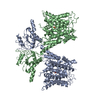+ Open data
Open data
- Basic information
Basic information
| Entry | Database: PDB / ID: 7xlm | ||||||
|---|---|---|---|---|---|---|---|
| Title | Human diastrophic dysplasia sulfate transporter SLC26A2 | ||||||
 Components Components | Sulfate transporter | ||||||
 Keywords Keywords | TRANSPORT PROTEIN / Transporter / sulfate | ||||||
| Function / homology |  Function and homology information Function and homology informationDefective SLC26A2 causes chondrodysplasias / Transport and metabolism of PAPS / Inorganic anion exchange by SLC26 transporters / sulfate transmembrane transporter activity / oxalate transmembrane transporter activity / chondrocyte proliferation / sulfate transmembrane transport / secondary active sulfate transmembrane transporter activity / solute:inorganic anion antiporter activity / bicarbonate transmembrane transporter activity ...Defective SLC26A2 causes chondrodysplasias / Transport and metabolism of PAPS / Inorganic anion exchange by SLC26 transporters / sulfate transmembrane transporter activity / oxalate transmembrane transporter activity / chondrocyte proliferation / sulfate transmembrane transport / secondary active sulfate transmembrane transporter activity / solute:inorganic anion antiporter activity / bicarbonate transmembrane transporter activity / chloride transmembrane transporter activity / microvillus membrane / chondrocyte differentiation / chloride transmembrane transport / apical plasma membrane / extracellular exosome / membrane / plasma membrane Similarity search - Function | ||||||
| Biological species |  Homo sapiens (human) Homo sapiens (human) | ||||||
| Method | ELECTRON MICROSCOPY / single particle reconstruction / cryo EM / Resolution: 3.73 Å | ||||||
 Authors Authors | Chi, X.M. / Zhou, Q. | ||||||
| Funding support |  China, 1items China, 1items
| ||||||
 Citation Citation |  Journal: Dian Zi Xian Wei Xue Bao / Year: 2023 Journal: Dian Zi Xian Wei Xue Bao / Year: 2023Title: Structure of human diastrophic dysplasia sulfate transporter SLC26A2 Authors: Chi, X.M. / Li, X.R. / Huang, B.D. / Zhou, Q. | ||||||
| History |
|
- Structure visualization
Structure visualization
| Structure viewer | Molecule:  Molmil Molmil Jmol/JSmol Jmol/JSmol |
|---|
- Downloads & links
Downloads & links
- Download
Download
| PDBx/mmCIF format |  7xlm.cif.gz 7xlm.cif.gz | 217.9 KB | Display |  PDBx/mmCIF format PDBx/mmCIF format |
|---|---|---|---|---|
| PDB format |  pdb7xlm.ent.gz pdb7xlm.ent.gz | 170.8 KB | Display |  PDB format PDB format |
| PDBx/mmJSON format |  7xlm.json.gz 7xlm.json.gz | Tree view |  PDBx/mmJSON format PDBx/mmJSON format | |
| Others |  Other downloads Other downloads |
-Validation report
| Summary document |  7xlm_validation.pdf.gz 7xlm_validation.pdf.gz | 1.1 MB | Display |  wwPDB validaton report wwPDB validaton report |
|---|---|---|---|---|
| Full document |  7xlm_full_validation.pdf.gz 7xlm_full_validation.pdf.gz | 1.1 MB | Display | |
| Data in XML |  7xlm_validation.xml.gz 7xlm_validation.xml.gz | 40.5 KB | Display | |
| Data in CIF |  7xlm_validation.cif.gz 7xlm_validation.cif.gz | 60.6 KB | Display | |
| Arichive directory |  https://data.pdbj.org/pub/pdb/validation_reports/xl/7xlm https://data.pdbj.org/pub/pdb/validation_reports/xl/7xlm ftp://data.pdbj.org/pub/pdb/validation_reports/xl/7xlm ftp://data.pdbj.org/pub/pdb/validation_reports/xl/7xlm | HTTPS FTP |
-Related structure data
| Related structure data |  33284MC M: map data used to model this data C: citing same article ( |
|---|---|
| Similar structure data | Similarity search - Function & homology  F&H Search F&H Search |
- Links
Links
- Assembly
Assembly
| Deposited unit | 
|
|---|---|
| 1 |
|
- Components
Components
| #1: Protein | Mass: 88273.945 Da / Num. of mol.: 2 Source method: isolated from a genetically manipulated source Source: (gene. exp.)  Homo sapiens (human) / Gene: SLC26A2, DTD, DTDST / Production host: Homo sapiens (human) / Gene: SLC26A2, DTD, DTDST / Production host:  Homo sapiens (human) / References: UniProt: P50443 Homo sapiens (human) / References: UniProt: P50443#2: Chemical | Has ligand of interest | Y | |
|---|
-Experimental details
-Experiment
| Experiment | Method: ELECTRON MICROSCOPY |
|---|---|
| EM experiment | Aggregation state: PARTICLE / 3D reconstruction method: single particle reconstruction |
- Sample preparation
Sample preparation
| Component | Name: human diastrophic dysplasia sulfate transporter SLC26A2 Type: COMPLEX / Entity ID: #1 / Source: RECOMBINANT |
|---|---|
| Molecular weight | Value: 0.13 MDa / Experimental value: NO |
| Source (natural) | Organism:  Homo sapiens (human) Homo sapiens (human) |
| Source (recombinant) | Organism:  Homo sapiens (human) Homo sapiens (human) |
| Buffer solution | pH: 7.4 |
| Specimen | Embedding applied: NO / Shadowing applied: NO / Staining applied: NO / Vitrification applied: YES |
| Specimen support | Grid material: GOLD / Grid type: Quantifoil R1.2/1.3 |
| Vitrification | Cryogen name: ETHANE |
- Electron microscopy imaging
Electron microscopy imaging
| Experimental equipment |  Model: Titan Krios / Image courtesy: FEI Company |
|---|---|
| Microscopy | Model: FEI TITAN KRIOS |
| Electron gun | Electron source:  FIELD EMISSION GUN / Accelerating voltage: 300 kV / Illumination mode: SPOT SCAN FIELD EMISSION GUN / Accelerating voltage: 300 kV / Illumination mode: SPOT SCAN |
| Electron lens | Mode: BRIGHT FIELD / Nominal defocus max: 2300 nm / Nominal defocus min: 1500 nm |
| Image recording | Electron dose: 50 e/Å2 / Film or detector model: GATAN K3 BIOQUANTUM (6k x 4k) |
- Processing
Processing
| Software | Name: PHENIX / Version: 1.14_3260: / Classification: refinement |
|---|---|
| CTF correction | Type: PHASE FLIPPING AND AMPLITUDE CORRECTION |
| 3D reconstruction | Resolution: 3.73 Å / Resolution method: FSC 0.143 CUT-OFF / Num. of particles: 395589 / Symmetry type: POINT |
 Movie
Movie Controller
Controller



 PDBj
PDBj



